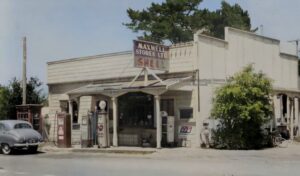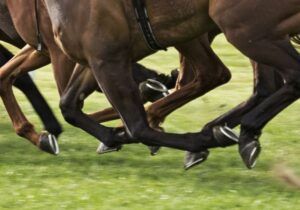1868: Maxwell Falls
February 28, 2022
By AHNZ
 Sgt. Major George Maxwell was a popular and dashing settler who defended his home against cannibalistic cultists, the new Hau Hau war chief Riwha Titokowaru. By 1866 all but one of the Red Coat regiments had departed New Zealand and by 1897 George Grey, the great architect of the latest Maori War was recalled back to Britain after his term of office expired to account for his campaigns. This left loyal New Zealanders, especially Taranaki Settlers and Maori, holding the bag in what was still a volatile frontier.
Sgt. Major George Maxwell was a popular and dashing settler who defended his home against cannibalistic cultists, the new Hau Hau war chief Riwha Titokowaru. By 1866 all but one of the Red Coat regiments had departed New Zealand and by 1897 George Grey, the great architect of the latest Maori War was recalled back to Britain after his term of office expired to account for his campaigns. This left loyal New Zealanders, especially Taranaki Settlers and Maori, holding the bag in what was still a volatile frontier.
On 9 July 1868 Titokowaru made his first strike by shooting and tomahawking three Taranaki settlers as they were felling and sawing timber. The killing, mutilating, and eating of settlers was a deliberate fear tactic revived by the chief from tribal tradition. It is also reminiscent of Vlad the Impaler’s famous terror tactics in C15th Romania or the Vlad the Assyrians of antiquity. Along with advertising his cannibalistic carnage by leaving part-eaten legs about the countryside, Titokowaru issued a proclamation saying “For I have eaten man – I have begun to eat the flesh of the white man..”
Chief Titokowaru was aided in his terrorism from 1867 by weapons a technology expert, American ex-British military Kimball Bent. Together their rampage proceeded very well, leaving the Settlers who had been abandoned by The State on the run. In September 1868 the rebels successfully repelled an attack on their fortress Te Ngutu O Te Manu/’The beak of the bird’ which also claimed the life of the famous Settler warrior Gustavus von Tempsky.
The Colonial New Zealanders needed to lift their game to turn the tide. They were forced to fight because the terrorists simply shot and tomahawked peacemakers who came to them under the flag of truce.
“In 1865 and 1866 all but one of the regiments sailed away. Thereafter the colonists and the Maori allies fought the war. Grey was summarily dismissed in 1868 for defying the Colonial Office once too often. In 1870 the last regiment was withdrawn, amidst howls of protest from the colonists, who felt that they were being sacrificed to the Hau hau in order to save a few pound in Gladstones’s budget.” – p144 Sinclair (1959)
“..Numbers of times the pakeha sent heralds of peace to us…This persistance irritated us more than our defeats had. We..fired upon their flags of truce, and shot and tomahawked their messengers, both pakeha and Maori, yet they still persisted.” – p935, Kowhai Ngutu Kaka, NZH (1971)
The New Zealanders once again took the fight to the one-eyed warrior priest Titokowaru and his fanatics, finding him dug in at a fort called Tauranga Ika¹ near Nukumaru. Captain John Bryce of the Kai-iwi Cavalry selected 4 riders to reconnoiter the pa on 28 December 1868. These were Sgt. Major Maxwell with Tropers William Lingard and the brothers Arthur and Henry Wright.
The Dash at Nukumaru
 The four troopers of the Kai Iwi Cavalry Volunteers, ordered by their Captain John Bryce, dashed in to see if Tauranga Ika was abandoned or defended. Maxwell was clean-shot through his chest, killed at once, in answer to this big question. The other brave troopers paid for their information dearly as well. Henry went down under the fire when out from the fort came the famous Maori warrior ‘Big Kereopa’ to hack him to death by tomahawk. Having escaped, Trooper Lingard rode back in again and rescued his companion for which he was awarded the New Zealand Cross.
The four troopers of the Kai Iwi Cavalry Volunteers, ordered by their Captain John Bryce, dashed in to see if Tauranga Ika was abandoned or defended. Maxwell was clean-shot through his chest, killed at once, in answer to this big question. The other brave troopers paid for their information dearly as well. Henry went down under the fire when out from the fort came the famous Maori warrior ‘Big Kereopa’ to hack him to death by tomahawk. Having escaped, Trooper Lingard rode back in again and rescued his companion for which he was awarded the New Zealand Cross.
Having paid a high price, Major General Whitmore now knew where to find his enemy. On New Year’s Eve the New Zealanders lay siege to the powerful Tauranga Ika.
Rather than repel this assault, as he had done before, Titokowaru’s forces made the fatal decision to fee overnight over a difficult cliff. Many, or most, were hunted down to be captured or killed within 2 days. During this great bush chase Major Te Rangihiwinui Kepa was in charge which was the first time European officers elected to serve under Maori command. Due to predilection or misunderstanding the Hau Hau terrorists were decapitated and the smoked heads were piled up in Whitmore’s war tent!
Titokowaru and Bent were among those who escaped but this was the end of the Hau Hau Wars. According to Bent, interviewed by James Cowen years later, a devastating collapse of Titokowaru’s leadership had occurred. The mystical warlord had disrespected his magical powers and taken the wife of another chief for his own lust, leading to catastrophic failure in the defenders’ resolve to fight.
To remember George Maxwell, the local farmer and volunteer trooper, who had given his life for the victory, a town was created named Maxwell. Sections of the new township began to be sold and settled in 1871. It’s a town named as part of a proud continuity with others in New Zealand for the men who fought for it but also made it possible. For example, Hamilton was named for Captain John Hamilton as Havelock and Havelock North are named for Major General Henry Havelock. Even Wellington is named after the Duke of Wellington just as Picton is named after Lieutenant-General Thomas Picton; The two ports together in New Zealand as their namesakes were in life.
“In truth , the Maoris of New Zealand, though they have never studied at Woolwich, are adepts in military engineering; instinct in their case has supplied the want Of science . The sites of their pas, which are simply redoubts built of earth and inclosed with a wooden palisade, have always been chosen with the double intention of inflicting the greatest possible injury on their assailants, and securing their own retreat when their position becomes untenable .” – Brave British Soldiers and the Victoria Cross, S. O. Beeton (1865)
“Captain Hamilton , of the 43rd, breathed only once after his body was found . A bullet had passed through his head, and so altered his features that it was difficult to recognise the handsome face with which we were once so familiar…He served in the 10th Regiment with the present Sir Henry Havelock, now on the staff in New Zealand, who always spoke of him with respect as a gallant soldier, and betrayed the deepest sorrow on learning that he had fallen.” – ibid
“Henry Wright’s horse…rolled on his rider’s leg, and pinned him to the ground. He lay in this helpless position within a very short distance of the stockade, from which. a heavy fire was coming; he kept firing his revolver at the palisade, but was unable to use his carbine. A Maori warrior, the locally celebrated Big Kereopa, presently came out from under the palisading with a ‘long-handled tomahawk, and Wright- would have been killed, had it not been for the promptitude of Trooper Lingard, who galloped up and helped him away.” – Trooper Lingard’s Brave Deed, Evening Post (1922); Papers Past
Maxwell men have given their lives in more wars since, especially as shown by the Maxwell War Memorial. It once had a school, now gone, and various other small town amenities. The Maxwell family long resided there and life went on the same much as it has done since the 1870s. Then, in the 1990s, some things that should not have been forgotten were lost.
Maxwell Falls
Not content to see Maxwell be killed once, New Zealand saw to it that he would be disgraced and fall a second time. In the 1880s an historian accused Maxwell of slaying Maori children, a claim defended successfully in court by Maxwell’s commander Captain Bryce at the time. This was Australian historian George Rusden in his History of New Zealand (1895.) However, that was not to be the end of the matter. One hundred years later the revisionist historian James Belich revived the 1880s story and ran with it in his own 1980s book. The story of slaughter involves the days before Tauranga Ika when Maxwell was one of the soldiers patrolling the Taranaki wastelands..
“…perceiving a considerable number about Mr Handley’s wool-shed, I directed some men to advance..and charged, killing eight with sabre, revolver, or carbine. I wish particularly to mention the extreme gallantry of Sergt. G. Maxwell of the Kai Iwi Cavalry, who himself sabred two and shot one of the enemy, and was conspicuous throughout the affair, many others of all corps behaved extremely well, but I think it would be invidious to particularise further.” – SMART ENGAGEMENT AT NUKUMARU. EIGHT HAU-HAUS KILLED. – Wanganui Herald (1868); Papers Past
“The name of the new township, Maxwell, was given in honor of the gallant Sergeant George Maxwell, who fell fighting in front of Tauranga Ika pa, in December, 1868.” – Wellington Independent (1871); Papers Past
 Though Rusden’s story was successfully defeated in court for telling lies it was dredged up again and used by Labour 5.0. Treaty Negotiations Minister Margaret Wilson (image right) said “Some aspects of the iwi’s history are truly devastating. In one incident, a group of children were killed and maimed by government militia. The scars of the survivors have been both physical and emotional, and naturally the resulting grief and anger has been passed from one generation to the next.” Ref. Ngaa Rauru Kiitahi: third Taranaki settlement signed, Beehive.govt (2003).
Though Rusden’s story was successfully defeated in court for telling lies it was dredged up again and used by Labour 5.0. Treaty Negotiations Minister Margaret Wilson (image right) said “Some aspects of the iwi’s history are truly devastating. In one incident, a group of children were killed and maimed by government militia. The scars of the survivors have been both physical and emotional, and naturally the resulting grief and anger has been passed from one generation to the next.” Ref. Ngaa Rauru Kiitahi: third Taranaki settlement signed, Beehive.govt (2003).
Labour 5.0 paid out some $30,000,000 “compensation” using the findings of these two historians as cover. Maxwell was disgraced. The tribe has since been shown to have squandered some 10% of that or more on risky financial deals. An Anarchist guess is that many of those investments were deliberately dodgy and went into the pockets of Labour 5.0 and its campaign contributors or else would never have been paid out in the first place!
“Te Whitinga Mark Huirua pleaded guilty in the High Court at Whanganui on Thursday to various charges related to his involvement with Taranaki iwi Ngā Rauru Kītahi.” – Man defrauds South Taranaki iwi of $3.1m, all lost on bad investments and personal spending; Stuff (Feb 2022)
“The iwi had taken a conservative approach to investing until then but on Huirua’s advice, it diversified into a more direct investment of funds including cryptocurrencies.” – Iwi loses millions to Australian-based fraudster, NZ Herald (Feb 2022)
“Mike Neho, Tumu Whakarae of Taranaki iwi Ngā Rauru Kītahi’s trust Te Kāhui o Rauru, said there have been “learnings” taken from the fraudulent activities of Te Whitinga Mark Huirua.” – Iwi ‘bitterly disappointed’ by multi-million dollar fraud, Stuff (Feb 2022)
Maxwell’s indignity does not end here. Along with his name being rubbished so that Labour 5.0 could give tens of millions of your money to an Iwi to play the financial markets even his town legacy is being erased. Again, this is occurring now in February 2022 as I write.
Vincent O’Malley was paid $10,000 by Hamilton ratepayers to do a hit job on some of their street names in 2020. Most of this was Vincent quoting books written by Vincent or re-treading the old tire of Belich as he had re-treaded old George Rusden. On top of O’Malley’s work putting down his fellow Irishman, Maxwell, a Spinoff writer, Bob Kerr, put the knife in saying the town of Maxwell must be re-named.
The pile of history books, parliamentary paperwork, and Spinoff pressure is apparently enough now that the change has occurred. Maxwell is now to be replaced with a made-up Maori name as of February 2022.
“”In 1868, a government militia led by George Maxwell fired on a group of unarmed Māori children, attacked them with sabres and killed two boys,” Haanen said.” – Maxwell, near Whanganui, becomes Pākaraka following approval of New Zealand Geographic Board recommendation, Wanganui Chronicle (Feb 2022)
So that is how New Zealand history is written and our heritage erased from the map. In this case it’s not even a duel name such as ‘Aotearoa New Zealand’ or ‘Mount Taranaki/Egmont’. The name isn’t even reverting to an authentic existing one such as Nukumaru or Taurangaiki or Okehu but a nice-sounding made up one² like Aotearoa. Maxwell is to be called Pakaraka.
Does the history flipping never end? No. Not only is the hero of Tauranga Ika trampled in the mud but the arch-villain is being revised as a far-seeing hero, if you can believe that?
Michael Burr, with a Masters Degree in History and Education, proposes that the insider account of Kimble Bent it part of some four-dimensional chess on the part of Riwha Titokowaru. He argues that Titokowaru knew his terror cell could not only hold Taurangi Ika but sweep away all the Colonial and Maori fighters. Riwha recognised that his religious cult was on the cusp of taking over New Zealand itself, from Auckland to Invercargill! Why didn’t he?
Titokowaru, Burr argues, saw that if he did not step back from his assured military success that the British Army would return to New Zealand and take over. The mystical chief, we are to believe, was a student of international politics and saw this coming done the line unless he did something to stop it. So, he tactically created a sex scandal and then strategically barely escaped with his life while half of his people were slaughtered and dispersed. No, I am not making this up.
“Under the circumstances, one more victory for Tītokowaru would in all probability be a Pyrrhic one. At the least, it would lead to direct rule of New Zealand from Britain, even as it had for India where, we now know, any form of self-determination or independence would take a further 80 years to attain. At worst, it could involve ethnic cleansing and genocide.
Tītokowaru’s choice was as simple as it was stark: win a battle and invoke the Devil’s Wind, or walk away from his greatest victory and hope for some kind of co-existence on whatever terms could be gained.
But how was that to be done? Having swept all before them, but lacking Tītokowaru’s vision, the Maori soldiery would need a much sounder reason indeed than ‘being tired of the violence of war’ to retire from the field. In modern terms, why should they change a winning habit?
So Tītokowaru manufactured one in terms they would understand, not only doing nothing he arguably hadn’t done before, but ensuring also that it was viewed as an insult that would provide the excuse sought.” – Tauranga-Ika: a revisionist view of Tītokowaru’s last feint, Stuff (2017)
Kimble Bent finally, according to Burr, executed this 1868 grand scheme in 1911 when it was revealed to Maoridom and the world. This is perhaps the greatest ever Maori apologist excuse for an arse-kicking ever told. The way things are going though it might become the basis for a future generations’ Margaret Wilson to grant another Treaty grievance pay-out. New Zealand history is absolutely hilarious. Stories like this are so true yet so strange that nobody could make them up yet we fall for every detail every time.
—
1 Tauranga Ika/Tauranga-a-hika/Taurangaiki
2 Note: Pakaraka is a real place 1.4km down the road from the locality of Maxwell. The new made-up place The State’s compelled speech wants us to call Pākaraka draws from that. Ref. Proposal considered by the Board on 20 April 2021 for: Pākaraka [altered from Maxwell (locality)], NZ Geographic Board (2021)
Image ref. Maxwell Service Station photo taken around 1960. Improved image by Kev’s Wanganui Riverboat History page, Facebook (2021)
Image ref. Dr. K Horse Sense
Image ref. Major General Sir George Stoddart Whitmore; diggerhistory
Note: Maxwell School shut down by National 4.0 on 27/4/1997; Ref. gazette.govt.nz
Ref. A History of New Zealand, Keith Sinclair (1959)
Ref. New Zealand’s Heritage (1971)
2 thoughts on "1868: Maxwell Falls"
Leave a Reply
 Like Comment Share
Like Comment Share






THERE are always two sides to a story and truth is usually somewhere in between. The Handleys Woolshed incident in november has to be put into perspective: it was a time of war, Titokowaru was known for setting ambushes and the safest policy was attack first ask questions later. The maori lads were raiding a settler farm hunting livestock, and the age of the lads- who had left the pa on an adventure- was only realised after the red haze had settled. The reality is not cold blooded slaughter of innocents but a spur of the moment attack on enemy persons raiding a settler farm.
Maxwell had had his house burnt down in September, so had skin in the game, and lost his own life in december assaulting the pa, so the reality is that there was loss and hurt on both sides. Cancelling the memories of loss on one side does not resolve division it only embeds and rekindles it.
Naming is a process of assertion. As you say Pakaraka pa is and always has been a separate entity. There is nothing to prevent local residents of Maxwell erecting their own signs on private land, preserving the name in usage, naming businesses and facilities with the prerfix “maxwell”
More importantly the community needs to make peace not divide itself over old wounds.
“There is nothing to prevent local residents of Maxwell erecting their own signs…”
That takes a lot of spirit because you must go up against the government law, government maps, government internet, government school lessons, government TV, government newspapers, government road signs. They’ll all have a monopolistic taxpayer-funded mainstream force asserting one thing and you’re supposed to try to say another. It’s an unequal contest of identity.
And that’s why we cannot have a State.